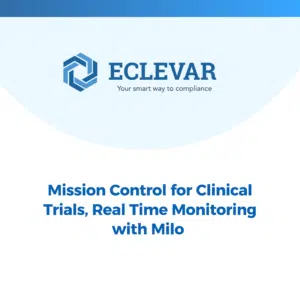Mission Control for Clinical Trials, Real Time Monitoring with Milo
Clinical operations teams face tighter timelines and higher expectations for live transparency. Regulators, sponsors, executives and patients all want continuous insight. Study teams have the expertise, yet limited resources mean they still rely on weekly exports and after-the-fact reconciliations. Each task means switching between isolated portals, which drains capacity and fuels burnout
Milo removes that friction. One secure workspace unites eCRF, ePRO, eConsent, documents and site collaboration, so a monitor can draft a visit report, verify source, pull credentials and schedule the next patient task without opening a second tab. Live dashboards, automated document capture and built-in quality checks keep every stakeholder informed in real time and surface issues instantly, freeing CRAs to spend more time on strategy and patient safety
Below we unpack why scattered tools no longer meet modern demands and how Milo’s all-in-one platform changes the game
1. The Problem — Fragmented and Reactive Monitoring
Monitoring remains scattered across portals and spreadsheets. Because reviews happen days or weeks after data entry, issues hide in plain sight
Missed safety signals
Adverse events are visible only at the next monitoring visit
Late discovery of protocol deviations
Deviations are found long after they can be corrected
Limited visibility on adherence and site performance
Insight is delayed until metrics are compiled manually
Documentation gaps before audits
Issues surface just before an inspection, creating fire drills and stress
The effect is magnified in decentralized trials or studies that include AI SaMD, where data volume is high and the risk profile is complex
2. Current Practice — Patchwork Systems and Periodic Visits
Most sponsors and CROs still depend on a mosaic of point solutions
Conventional EDC platforms in silos
Core data capture is isolated from other workflows
Stand-alone tools
ePRO, eConsent, site contracting and document management live in separate portals
Periodic monitoring cycles
Visits or data reviews occur every few weeks, sometimes monthly
Even in 2025, most monitoring workflows remain backward looking. Integrations are fragile and real-time views are reserved for costly bespoke setups
3. How AI Has Advanced Monitoring
Recent AI progress makes proactive oversight possible
Continuous reading of patient signals
Streams from ePRO, wearables and telehealth notes are analyzed in near real time
Prediction of deviations and dropouts
Models flag risk before events occur
Automatic reconciliation and queries
Data cleaning, resolution and risk-based triggers are accelerated
Instant narratives and dashboards
Safety summaries and site performance views generate on demand
Lifecycle analytics for AI SaMD
Drift and bias are detected via event logging and longitudinal metrics
These gains remain limited when insights sit inside isolated tools
4. Making Milo Relevant
Milo brings every stream together and layers intelligence on top, turning monitoring from a cost center into a strategic asset
Unified Monitoring Hub
eCRF, eConsent, ePRO, wearables and clinician notes flow into one evidence lake, searchable and audit ready
Real-Time Dashboards
Live status on safety, adherence, protocol deviations and AI SaMD performance
AI-Augmented Alerts
Emerging risks are routed to medical monitors or data managers immediately
Audit Ready by Design
Every action and data point is versioned and mapped to GCP and ISO requirements
Patient-First Design
Participant signals are contextualized and acted on within minutes, not days
Bonus — Built for the New EU Rules
With MDCG 2025-6 and the AI Act, active post-market monitoring is mandatory. Milo covers the workflow from first-in-human to real-world evidence without additional middleware or manual rework
The Takeaway
Delayed, manual monitoring is no longer acceptable. AI advancements create the opportunity for continuous oversight, and Milo turns that opportunity into a single, intuitive workspace. The result is faster trials, safer patients and smoother inspections
